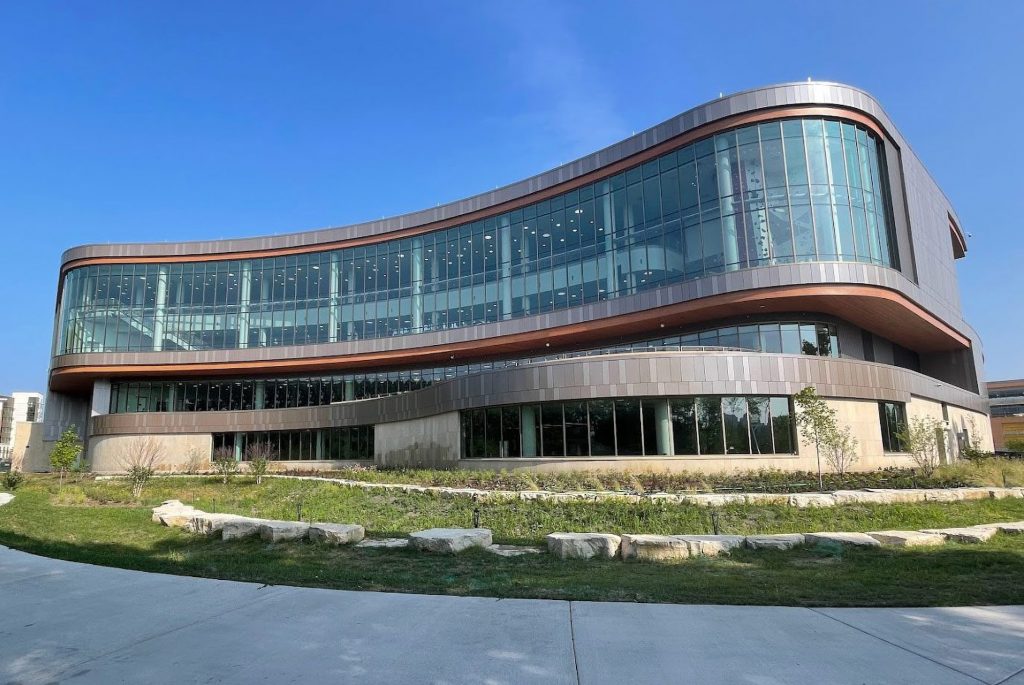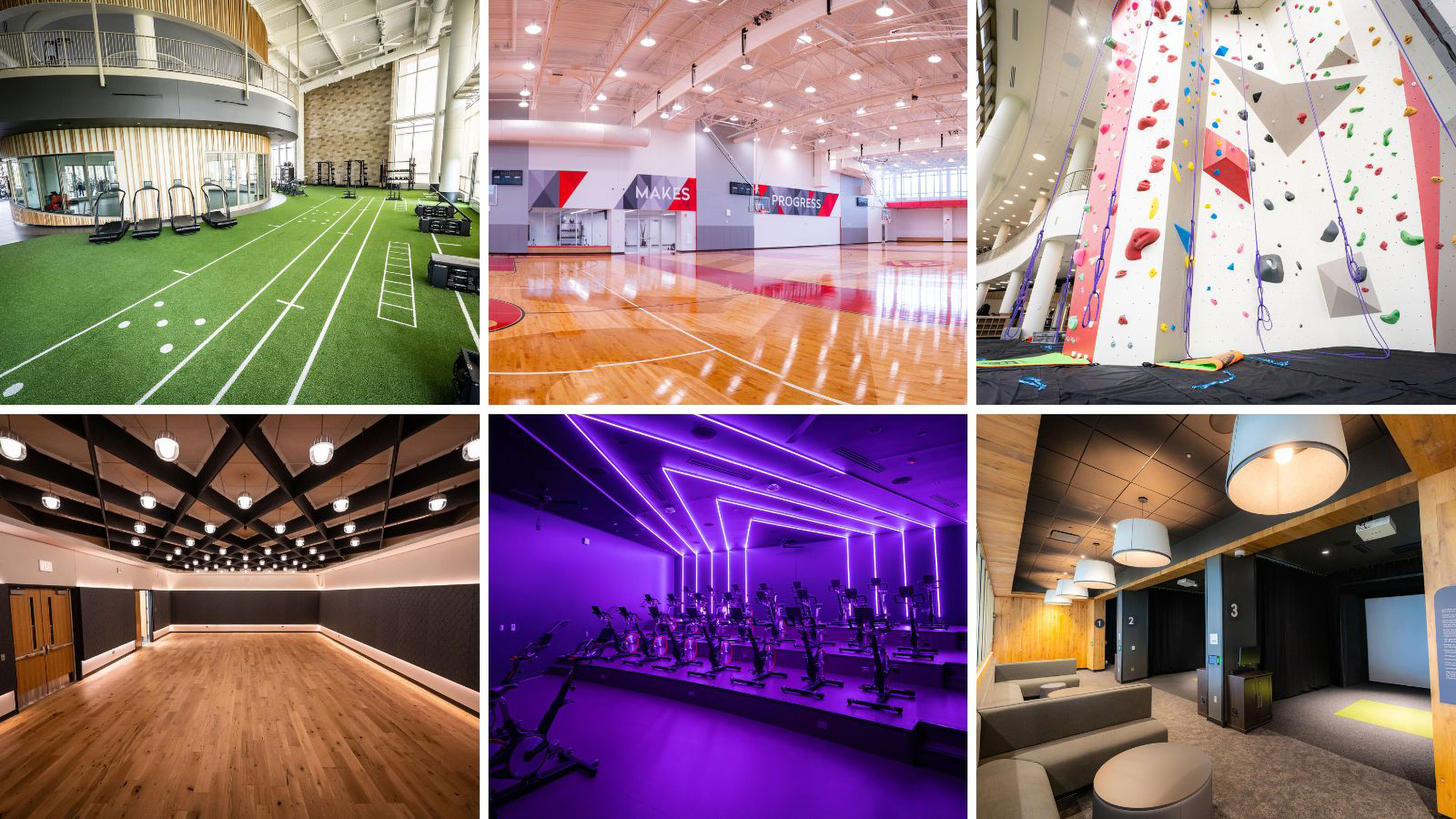How university rec centers are evolving to support wellbeing

In 2018 the University of Madison-Wisconsin’s recreation department changed its name from Recreational Sports to Recreation & Wellbeing in a deliberate move to broaden its service offerings. Since then, Recreation & Wellbeing (a.k.a. Rec Well) has opened two new HOK-designed rec centers that showcase the university’s commitment to wellbeing.
This is especially true in the newly opened Bakke Recreation & Wellbeing Center, which includes a teaching kitchen, mind-and-body studios, nap pods, sports simulators and spaces to support massage therapy, wellness coaching, and meditation.
In a recent LinkedIn Live, Recreation & Wellbeing’s Sadat Khan and Abby Diehl joined HOK architect Emily Ostertag to discuss UW’s new facilities and the growing trend to design and program rec centers to support mental wellbeing and holistic health. Athletic Business Magazine’s Andy Berg moderated the conversation.
Welcoming More Users
Sadat Khan, Senior Associate Director of Facility Planning and Operations for Rec Well, spoke of the need to make rec centers more inclusive and appealing.
“Before we started building our new rec centers, about 75% of the student population was using our facilities,” he said. “That’s good. But for a school the size of Wisconsin, it also meant up to 15,000 students were not using our spaces. So, that was a number we focused on. We needed to become more inclusive and more accessible. We worked hard to remove barriers to get people more engaged. Wellbeing was a big part of that.”
Addressing Student Needs
To ensure its new buildings met the needs of all their potential users, Rec Well surveyed students, asking them what type of wellness services and programming they wanted to see.
“The students highlighted some big buckets for us, including peer support programs, meditation, massage therapy and nutrition education,” said Abby Diehl, Rec Well’s Associate Director of Wellbeing. “We wanted to create a holistic approach around wellness and wellbeing. Rec Well is not just a place to workout. We are so much more than that.”

Inclusive Design & Programming
Emily Ostertag, a designer who worked on both of Rec Well’s new facilities, discussed how rec centers can make people of all fitness levels feel comfortable. One way is by providing a variety of programming. Bakke, for example, includes traditional rec center programming, such as weight rooms and hardwood courts, and non-traditional spaces such as a climbing wall and eSports studios. Another way to make users feel comfortable is by creating “neighborhoods” within the building for people of various fitness levels.
“Rec centers tend to be large, open buildings that can feel overwhelming. To balance that, we created more privatized areas—fitness neighborhoods—that make people feel more comfortable. I compare them to the booths in a restaurant that offer passive privacy. You can still see what’s going on elsewhere, but you feel like you’re in your own private zone.”
Wellness Strategies for Existing Spaces
University of Wisconsin’s new rec centers benefit from a better understanding of wellbeing than existed just a decade or two ago. Yet universities with older facilities can add wellbeing elements to existing rec centers. The panel offered several suggestions for modifying older facilities, including:
Khan spoke of ways to bring the outdoor elements inside the facility, such as a popular space within Bakke that features artificial turf and double-height windows that allow for lots of natural light.
Diehl discussed how plants, artwork, wall colors and environmental graphics can be used to benefit wellbeing.
Ostertag suggested older rec centers audit how their existing spaces are used and how they might adapt to new uses and programming. “For example, racquetball is not as popular as it once was, said Ostertag. “Yet some existing facilities have 10 racquetball courts and only two are in regular use. Those courts can be great spaces to retrofit into a new use such as a wellbeing space, a spin studio, or something else.”

You Can’t Spell Recruitment Without Rec
While Rec Well’s new facilities were designed to address the needs of UW students, there’s no doubt the rec centers are also making an impression on students far beyond Madison.
In response to a question about how rec centers can aid recruitment, Khan told a story about one of Rec Well’s previous facilities, an outdated building known as the SERF.
“Our campus tour guides wouldn’t even bring people to the building. They’d point to it and say, ‘That’s the SERF’ and then walk in the other direction. Now, we are one of the stops on the tour. That’s a huge difference,” said Khan. “I’ve shown our new buildings to prospective students who are leaning toward going to other schools. After they see these spaces and how impressive and inclusive they are, they change their mind and say, ‘You know, I really need to consider coming here instead.’ That’s a big deal.”
The post "How university rec centers are evolving to support wellbeing" appeared first on Building Design & Construction

